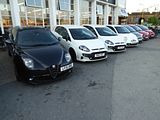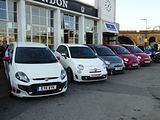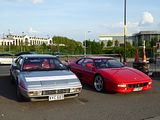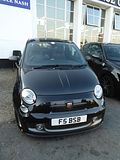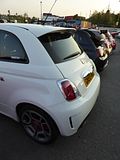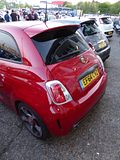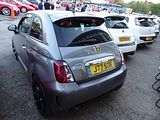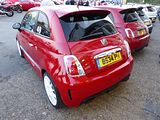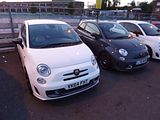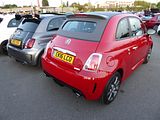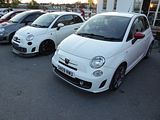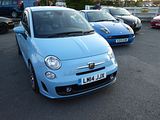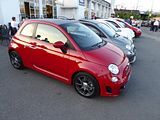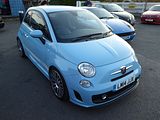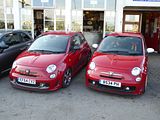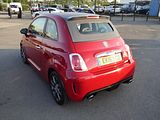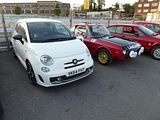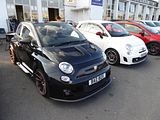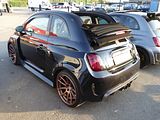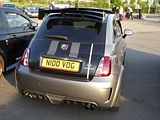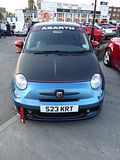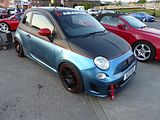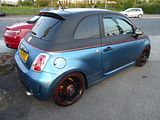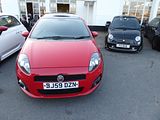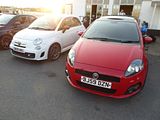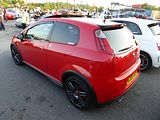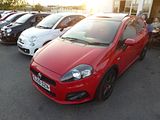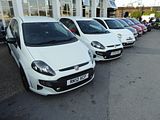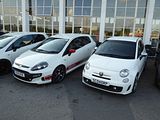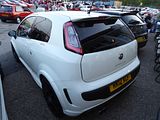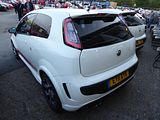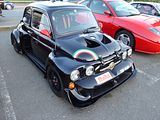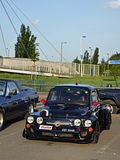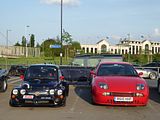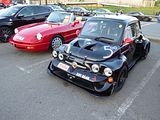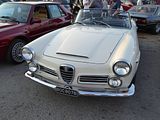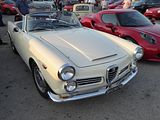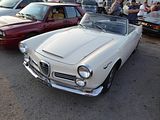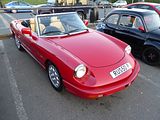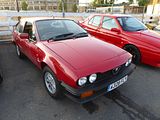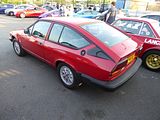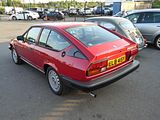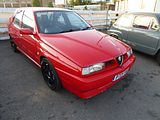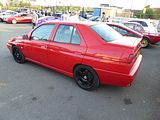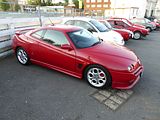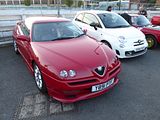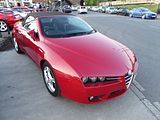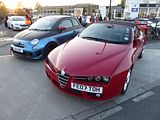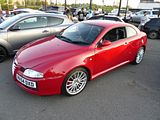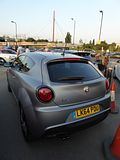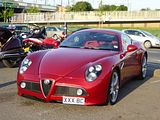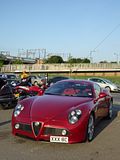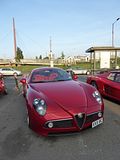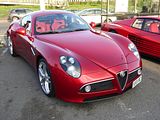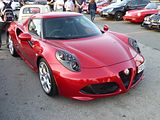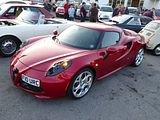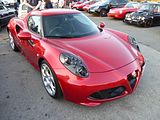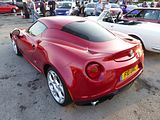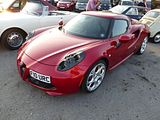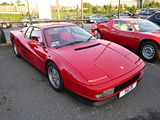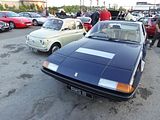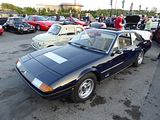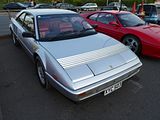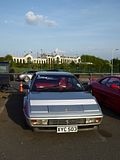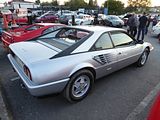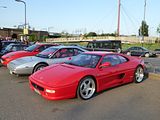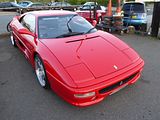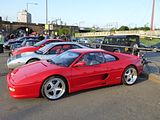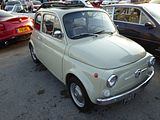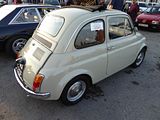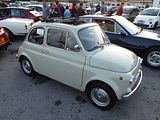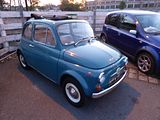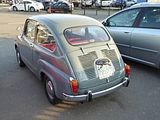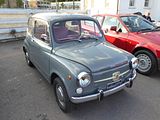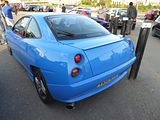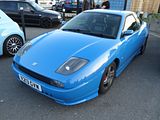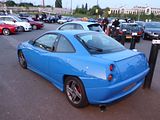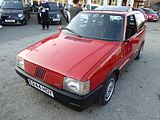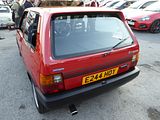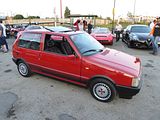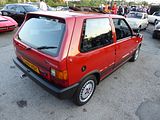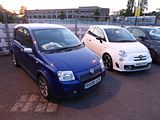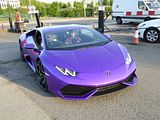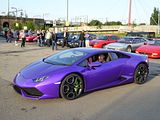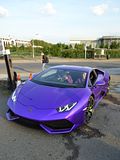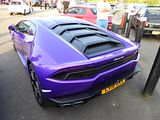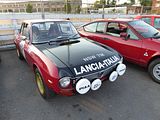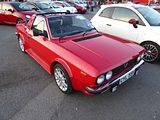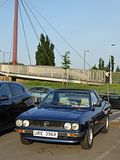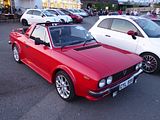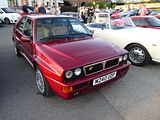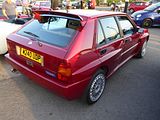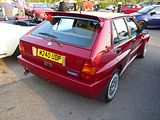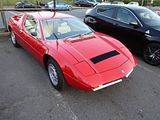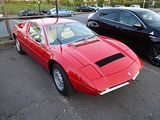Yet again, a report which starts by commenting on the weather, since it does have a significant bearing on car events in the UK, especially those where no pre-booking is required. After a particularly mild winter, temperatures struggled to reflect Spring throughout April, but as the days ticked over into May, that all looked to change, just as the car events seasons started to get underway. Indeed by the first full weekend of the month, some warm air arriving from Africa made it feel like our patience was to be rewarded, with many parts of the country getting genuinely hot. But as so often happens, the joy of the sunshine and heat was very shortlived, as we were then drenched in three days of solid and heavy rain, just in time for the second week of the month, when the most interesting themed evenings take place at the legendary Ace Cafe. I abandoned plans to go to the Tuesday evening “Classic Cars” night, as although by the time I was free to go, it had finally stopped raining, this was only long after most people would have decided to stay away. But for the Thursday evening, the Italian Car night, the forecast suggested that the sun would make a welcome reappearance, and indeed the whole day stayed dry. With the prospect of evening light until well after 9pm, I set off from Central London around 5pm, full of anticipation for a busy evening and lots of lovely Italian machinery which should be on show. I came across a Ferrari 458 and Lamborghini Huracan clearly in convoy, and wondered if although they took a different turning from, if I would see them at the Ace. I did not, and nor did I see the Ferrari 458 Speciale which was coming in the opposite direction around the North Circular, but by the time I eventually arrived on site, there was lots of stuff parked up. cars continued to arrive during the evening, though the forecourt was not quite full. Although there were onsite many familiar cars and their owners, there were also plenty of cars I had not seen before, giving lots of variety. The sun turned out to be a mixed blessing, though, as the buildings behind the Cafe had been demolished, so the shadows get very long indeed before the sun finally sinks low enough, so getting photos was a struggle until well into the evening. But, with few cars making an early exit, this was not an undue problem, and there was ample time to talk to friends and enthusiasts on site, get the photos you will see here and to grab one of the tasty Burgers and a mug of coffee, before heading off at around 10pm. Many had gone, but there were still plenty of cars left even at that time, a sure sign that there were plenty of people enjoying their evening.
ABARTH
Definitely the dominant marque of the evening, there were as many as 20 Abarth models present, though a couple of them had to be parked out on the road, at least initially. There was a nice mix of Cafe regulars, with their well known cars, as well as plenty of people making their first appearance here, at least with an Abarth. As ever, the 500-based models dominated, with a nice array of the different versions offered in the 7 years that the model has been on sale in the UK, ranging from Paul Feldman and Paul Hatton’s 500 Esseesse cars to the recent deliveries such as Steve Elliott’s 16 plated 595C and the latest limited production 595 Yamaha model finished in Podium Blue, the colour which has become a firm favourite for everyone.
Not all the cars were quite standard, to put it mildly, and those which have been customised to meet the tastes of their owners were certainly attracting plenty of attention. Among these was “Bad Box”, Mario Cee’s 595C.
There were a trio of Punto cars here, too, with Daniel Ciercierski’s Grande Punto joined by a couple of the later Punto Evo cars.
The only “classic” Abarth here was the well known car belonging to Carlo Caccaviello. Although this amazing machine has the form of a classic Nuova 500, don’t be too taken in by that. The car is actually built on a chassis that has its origins in the Abarth Osella 2000SP sports racing car, with double wishbone suspension and disc brakes front and rear. Sitting in the back is a fuel injected 1.5 litre Alfa Romeo “boxer” engine of the type originally found in the front of the Alfa Romeo ‘Sud, Sprint 33 and even the Nissan Arna GTi. It is coupled to an Alfa 5-speed gearbox. Carlo’s coachwork company built the special extra wide body, which is all steel. The car was first registered in the UK on the 28th July 2000 and it has been seen at a great variety of events ever since. It never fails to pull the crowds wherever it its taken.
ALFA ROMEO
The Abarths were not the cars to generate lots of interest, as there were several rather desirable Alfa models here which drew nothing but praise and adulation from those present. Oldest of these was this splendid 2600 Spider. Although this car was produced in the early 1960s, it goes back to the 50s when Alfa produced their 102 Series cars, to sit above the Giulietta range that marked the brand’s transition from being a maker of exclusive coachbuilt and racing cars to one that offered volume production models. The 102 was never likely to be a big seller, in a world that was still recovering economically from the ravages of the Second World War, but it was an important flagship, nonetheless. The 2000 models ran for 4 years, from 1958 to 1962, at which point they were updated, taking on the name of 106 Series, with minor styling changes being accompanied by a larger 2600cc engine under the bonnet. As with the 2000 models, the new 2600 cars were sold in Berlina (Saloon), Sprint (Coupe) and Spider (Convertible) versions, along with a dramatically styled SZ Coupe from Italian styling house Zagato and a rebodied Berlina from OSI, all of them with an inline twin overhead cam six cylinder engine of 2.6 litres, the last Alfas to offer this configuration. Just 6999 of the Sprint models were made and 2255 Spiders, very few of which were sold new in the UK where they were exceedingly expensive thanks to the dreaded Import Duty which made them much more costly than an E Type. Many of the parts were unique to these cars, so owning one now is far harder than the more plentiful 4 cylinder Alfas of the era. Whilst the rather square styling of the Berlina, which won it relatively few friends when new and not a lot more in recent times means that there are few of these versions to be seen, the Sprint and Spider models do appear from time to time, and market interest in the cars is now starting to accelerate, with values rise accordingly. There is no doubting the fact that this 2600 Spider looks absolutely fantastic, even if an article in “Classic and Sports Car” magazine last year had to conclude (reluctantly, given the declared bias of the author) that the contemporary Lancia Flaminia was actually the better car.
There was a second open topped Alfa here, and this was a much more familiar model, an example of the long running 105 Series, and seen in the final S4 guise. The S4, the final major change to the long running Spider came in 1990, and mechanically, the biggest different was the use of Bosch Motronic electronic fuel injection with an electric fan. Externally, the Spider lost its front under-bumper spoiler and the rather ungainly rear boot spoiler of the S3, and picked up 164-style rear lights stretching across the width of the car as well as plastic bumpers the same colour as the car. This also marked the first generation of the car with automatic transmission, as well as on-board diagnostics capabilities. The car had remained in production largely thanks to continued demand in North America, though this market had to wait until 1991 for the changes to appear on their cars. European markets were offered a car with a 1600cc engine and carburettors as well as the 2 litre injected unit. Production finally ended in 1993, with an all new model, the 916 Series Spider appearing a year later. The car was not officially sold in the UK, but plenty have found their way to our shores since then.
There were a couple of nice Alfetta GTV models here. As was still the practice in the 1970s, Alfa followed up the launch of the Alfetta Berlina with a very pretty coupe. Styled by Giugiaro, this car, initially called the GT, and premiered in the autumn of 1974, looked completely unlike the saloon on which it was based. The first cars had 1.8 litre four cylinder engines and then in 1976 the range was expanded both up and down with a 1.6 and a 2.0 model, the latter adopting the legendary GTV name. In 1981, with the 2.5 litre V6 engine that had been developed for the ill-fated Alfa 6 luxury saloon available, Alfa was able to create a true rival for the 2.8 litre Capri with the GTV6. A facelift modernised the look of the car with plastic bumpers front and rear and a new interior looked rather better as well as being more ergonomically logical. Both the cars to be seen here were these facelifted models, one of them with the 2.5 litre engine and the other, as evidenced by a bonnet that lacks the raised portion, a 2 litre model.
The 155 was one of a series of cars built by the Fiat Group on a shared platform, the so called Tipo 3 or Tipo Tre, which sat under the Fiat Tipo, and Lancia Delta 2, as well as the Fiat Coupe. Built to replace the rear wheel drive 75, the 155 was somewhat larger in dimension than its predecessor. The 155 was designed by Italian design house I.DE.A Institute which achieved an exceptional drag coefficient of 0.29, and the rather boxy design gave the car a sizeable boot, as well. The single most significant technical change from the 75 was the change to a front-wheel drive layout. This new configuration gave cost and packaging benefits but many Alfa die-hards and the automotive press lamented the passing of the “purer” rear-wheel drive layout on a car from this sporting marque. Not even the availability of the 155 Q4, which had a 2.0-litre turbocharged engine and a permanent four-wheel drive powertrain, both derived from the Lancia Delta Integrale; making the car essentially a Lancia Delta Integrale with a different body was enough to win the sceptics over. Reception of the model was generally lukewarm. The 75 had been conceived prior to Fiat’s acquisition of the Alfa brand, so as “the last real Alfa” it cast rather a shadow over the 155; the loss of rear-wheel drive was frequently cited as the main cause of the disappointment. Nevertheless, the 155 was entered in Touring Car racing and was successful in every major championship it entered, which gradually improved its image. Belatedly, the factory introduced a wider version in 1995 (the “wide-body”) which as well as a wider track and revised steering based on racing experience or requirements, also brought in new 16-valve engines for the 1.8 and 2.0-litre whilst retaining the 2.5 V6 and making some improvements to cabin materials and build quality. There were several Sport Packs available, including a race-inspired body kit (spoiler and side skirts) and black or graphite-coloured 16-inch Speedline wheels. The more genteel could opt for the Super which came with wood inserts in the cabin and silver-painted alloy wheels. With this version, the 155 really came good. When production ceased in 1998, following the launch of the 156, 192,618 examples had been built. These days, there is quite a following for 155s, and you often see several of them at this venue. There was just the one this month, one of the wide-bodied cars.
Sharing some of the same underpinnings as the 155 were the 916 Series cars, which came as the GTV and Spider. These popular classics are often one of the best represented of all modern Alfas at event. here tonight was just car, a GTV Cup. This is perhaps the best known of the limited edition cars produced during the model’s lifetime. Sold new in 2001, UK market Cups were based on the 3.0 V6 version, and inspired by a one-model Alfa GTV Cup race series, 419 of these cars were made. There were 180 3.0 V6 24V GTV Cups, out of which 155 were RHD versions and there were also 239 cars with 150 PS 2.0 TS, available in LHD only. The 3.0 V6 cars were only produced in red, while 2.0 TS cars were mostly silver with a few examples in red. Limited edition plaques, that were made of silver, differed for the RHD and LHD versions, having red and black texts accordingly. The differences between the standard car and the Cup version were a factory standard rear spoiler, front spoiler, side skirts, wheel arch side vents and titanium-like finish 17″ ‘telephone dial’ alloys, whilst mechanically the car was the same as the regular 215 hp V6. The interior was different in that it had leather-material upholstery.
Follow on to the 916 series were the Brera models. Visually similar to the 159 models at the front, the Brera and Spider boasted unique styling from the A pillars rearwards. They were offered with the same range of engines as the 159, and thanks to that strong, but rather heavy platform on which they were built, even the 3.2 litre V6 cars were more Grand Tourer than rapid sports car. Pininfarina was responsible for both models. The Brera was first to market, in 2005, with the Spider following in 2006. Production of both ceased in late 2010, by which time 12,488 units of the Spider and 21,786 units of the Brera had been built. It will be very surprising if these do not attain classic status, and the consequent rise in values, though that has not happened yet.
More recent models included an example of the GT and a couple of MiTo as well as Dan Deyong’s very smart black Giulietta Quadrifoglio.
If I had to pick just one car from the entire evening as the one I could take away and keep, I think, it would have to be this, a splendid 8C Competizione. Not only is it one of the nest looking cars produced in recent years, but the noise it makes is just something else. The press may have been rather critical of it when it was new, but for me, it pretty much hits every spot apart from the fact that I cannot afford it! First seen as a concept car at the Frankfurt Motor Show in 2003, the concept was conceived as a reminder for people who were perhaps slightly disillusioned with contemporary Alfa products that the company could still style something as striking in the 21st century as it had been able to do in the 1950s and 1960s. Public reaction was very positive, but Fiat Group Execs were very focused on Ferrari and Maserati and they were not entirely convinced that a car like this was appropriate as it could encroach on those brands’ territory. It was only in 2006, with new management in place that it is decided that a limited production run of just 500 cars would give the once proud marque something of a boost. Announcement of the production version, visually little different from the 2003 concept car was made at the 2006 Paris Show, and it was soon evident that Alfa could have sold far more than 500 cars To turn the concept into reality, Alfa used a shortened Maserati Quattroporte platform with a central steel section, subframes front and rear and main outer panels that were all made from carbon fibre, with the result that the complete car weighed 300 kg less than the GranTurismo. Final assembly was carried out by Maserati, with the cars being built between 2007 and 2010. Competiziones (Coupes) first, and then 500 Spiders. Just 40 of the Competizione models came to the UK. Most of them were sent to the US, so this car is exceptionally rare and is much sought after by collectors. They were fearsomely expensive when new, listing for around £150,000, but prices have never dipped far below this, so anyone who bought one, should they ever feel the need to sell it, is not going to lose money on the car.
Several speculators thought that they could pull off the same trick with the smaller 4C Competizione, an example of which was also here, but that has not proved to be the case, with a large number of cars being optimistically offered for sale a few weeks after the first deliveries, at well over list price, but failing to sell. It just goes to prove how fickle the exotic car market is.
FERRARI
This is never the place where you are likely to see large numbers of Ferrari models, and if it is, or has recently been raining, chances are you could see none at all, but thanks to the evening sunshine, there were 4 cars here tonight. The one attracting the most interest – unsurprisingly – was a Testarossa. It may be a while since posters of this car were a common feature on young enthusiasts’ bedroom walls, but there is a generation out there who would tell you that they had one, probably with a Countach poster alongside it. A replacement for the BB512i, the final iteration of Ferrari’s first ever mid-engined road car, the Testarossa was launched at the Paris Show in October 1984. The Pininfarina-designed car was produced until 1991, with the same basic design then going through two model revisions, with the 512 TR and later F512 M which were produced from 1992 to 1996 before the model was replaced by the front-engined 550 Maranello. Almost 10,000 Testarossas, 512 TRs, and F512 Ms were produced, making it one of the most-produced Ferrari models, despite its high price and exotic design. In 1995, the F512 M retailed for £136,500. The Testarossa followed the same concept as the BB512, the model it replaced, but was intended to fix some of the criticisms of the earlier car, such as a cabin that got increasingly hot from the indoor plumbing that ran between the front-mounted radiator and the midships-mounted engine and a lack of luggage space. This resulted in a car that was larger, and at 1,976 millimetres (78 in) wide the Testarossa was half a foot wider than the Boxer and immediately condemned for being too wide, though these days it does not appear anything like as wide as it did when new. This resulted in an increased wheelbase that stretched about 64 mm (2.5 in) to 2,550 mm (100 in) which was used to accommodate luggage in a carpeted storage space under the front forward-opening lid. The increase in length created extra storage space behind the seats in the cabin. Headroom was also increased with a roofline half an inch taller than the Boxer. The design came from Pininfarina with a team of designers led by design chief Leonardo Fioravanti, the designer of many contemporary Ferraris. The design was originated by Nicosia, but the guidance of Fioravanti was equally important. Being a trained aerodynamicist, Fioravanti applied his know-how to set the aerodynamics layout of the car. This meant the large side intakes were not only a statement of style but actually functional – they drew clean air to cool the side radiators and then went upward and left the car through the ventilation holes located at the engine lid and the tail. As a result, the Testarossa did not need a rear spoiler like Lamborghini’s Countach yet produced zero lift at its rear axle. The aerodynamic drag coefficient of 0.36 was also significantly better than the Lamborghini’s 0.42. Pininfarina’s body was a departure from the curvaceous boxer—one which caused some controversy. The side strakes sometimes referred to as “cheese graters” or “egg slicers,” that spanned from the doors to the rear wings were needed for rules in several countries outlawing large openings on cars. The Testarossa had twin radiators in the back with the engine instead of a single radiator up-front. In conjunction the strakes provided cool air to the rear-mounted side radiators, thus keeping the engine from overheating. The strakes also made the Testarossa wider at the rear than in the front, thus increasing stability and handling. One last unique addition to the new design was a single high mounted rear view mirror on the driver’s side. On US based cars, the mirror was lowered to a more normal placement in 1987 and quickly joined by a passenger side rear view mirror for the driver to be able to make safe easy lane changes. Like its predecessor, the Testarossa used double wishbone front and rear suspension systems. Ferrari improved traction by adding 10-inch-wide alloy rear wheels. The Testarossa drivetrain was also an evolution of the BB 512i. Its engine used near identical displacement and compression ratio, but unlike the BB 512i had four-valve cylinder heads that were finished in red. The capacity was 4,943 cc, in a flat-12 engine mid mounted. Each cylinder had four valves, lubricated via a dry sump system, and a compression ratio of 9.20:1. These combined to provide a maximum torque of 490 Nm (361 lb/ft) at 4500 rpm and a maximum power of 390 hp at 6300 rpm. That was enough to allow the Testarossa to accelerate from 0–60 mph in 5.2 seconds and on to 100 mph. The original Testarossa was re-engineered for 1992 and released as the 512 TR, at the Los Angeles Auto Show, effectively as a completely new car, with an improved weight distribution of 41% front: 59% rear. The F512 M was introduced at the 1994 Paris Auto Show, with the M standing for “modificata”. That car is easy to spot as it lost the pop-up headlights and gained awkward glazed in units.
The V12 engined car was a 400i, the large and long running 4 seater that has languished in the doldrums of affection for far too long, but which is gradually gaining new fans, as people realise that it is not just worthy of the Ferrari badge on the front, but also an elegant and surprisingly practical Grand Tourer. The 400 was an evolution of the 365 GT4 2+2, which was first seen at the 1976 Paris Motor Show. It proved quite controversial, as this was the first Ferrari to be offered with an automatic gearbox, a Borg Warner 3-speed unit, though a five speed manual was also offered. The 365’s V12 engine had been stroked to a displacement of 4.8 litres and given six 38 DCOE 110-111 Webers, and now produced 340 PS. 0-60 mph took 7.1 seconds. Other changes compared to the 365 GT4 included five-stud wheels to replace the knock-off hubs (Borrani wheels weren’t offered anymore), a revised interior, the addition of a lip to the front spoiler, and double circular tail light assemblies instead of triple. A total of 502 examples were produced, 355 of which were Automatics and 147 GTs before a further upgrade in 1979 which saw the addition of fuel injection. It was replaced by the visually similar 412i in 1985. which had a larger 5 litre engine. Production of this version ran for 4 years, meaning that by the time the model was deleted from the range, this elegant Pininfarina design had been produced for 17 years, the longest run of any Ferrari bodystyle ever. It was some years before another 4 seater V12 Ferrari would join the range, the 456 GT in 1994.
Another car which finds relatively little favour is the Mondial, a nice 3.2 example of which was on show. The Mondial was launched in 1980, as a replacement for the 308 GT4 Dino and it did not immediately garner much praise or enthusiasm, but as is the case when Ferrari release a slightly disappointing car, modifications soon came to make it better. A 4 valve per cylinder engine gave it more power before the capacity was upped to 3.2 litres in 1986, by which time the car was really rather nice, and the later models have a 3.4 litre engine, which was turned through 180 degrees from the initial installation to create the 3.4t. A stylish Cabrio was included in the range.
Final Ferrari of the evening was an F355, by common consent one of the best looking models to come out of Maranello, though the wheel trims on this particular car were not really to my taste. This is another example of how Ferrari took criticism to heart, as the F355 was a thorough reworking of the 348 model which was seen as something of a disappointment, and when it started losing out in Group Tests to upstarts like the Honda NS-X, a revamp changed most of the underpinnings of the car and also improved the styling, to create an absolute masterpiece and a class leader.
FIAT
As was the case last month, there were two examples of the Nuova 500 here. This time, though, they were the later 500F, as opposed to the 500D cars that had been in April. The most obvious difference between the D and the F is the fact that the latter introduced front hinged doors. The 500F was introduced in 1965 and ran through to 1975, remaining in the range as a cheaper model when the slightly less basic 500L joined it in 1968.
The Nuova 500’s larger brother was also here, the 600. You don’t see these cars that often, as the model was deleted from the UK range in 1964 when it was replaced by the larger 850, though in fact this is also at least the second consecutive month when there has been on at this venue. Admittedly, it has been the same car, but given how few of them are in the UK and on the road, that is not so much of a surprise. These days the 600 is somewhat overshadowed by the smaller 500, but in its day this was probably the more significant car. Codenamed Progetto 100 (“Project 100”), the Fiat 600 mirrored the layout of the Volkswagen Beetle and Renault 4CV of its era. Aimed at being an economical but capable vehicle, its design parameters stipulated a weight of around 450 kg with the ability to carry 4 people and luggage plus a cruising speed of no less than 85 km/h. A total of 5 prototypes were built between 1952 and 1954, which all differed from one another. Chassis number 000001 with engine number 000002 is believed to be the sole remaining example. It was powered by an innovative single-cam V2-cylinder engine designed to simplify maintenance and did not feature a clutch pedal. At the official launch in 1955, FIAT engineer, Dante Giacosa declared that the aim had been to create something new, both in the interest of progress and simplification. This prototype, however, did not become the chosen design. When the car made it to production, with a launch at the 1955 Geneva Show, it was christened the 600. It had hydraulic drum brakes on all four wheels. Suspension was a unique single double-mounted leafspring—which acts as a stabiliser—between the front wheels coupled to gas-charged shock absorbers, and an independent coil-over-shock absorber setup coupled to semi-trailing arms at the rear. All 600 models had 3-synchro (no synchro on 1st) 4-speed transaxles. Unlike the Volkswagen Beetle or Fiat 500, the Fiat 600 was water-cooled with an ample cabin heater and, while cooling is generally adequate, for high-power modified versions a front-mounted radiator or oil cooler is needed to complement the rear-mounted radiator. All models of the 600 had generators with mechanical external regulators. The first cars had a 633 cc inline-four cylinder engine which max-ed out at 59 mph. Sales were brisk, as it was just the right size for a market still recovering from the war of the previous decade. A year after its debut, in 1956, a soft-top version was introduced, and it was followed by a six-seater variant—the Fiat 600 Multipla, the very definite precursor of current multi-purpose vehicles. By 1957, assembly started in Spain, where the car would go on to become a legend, and where you can still see large numbers of them certainly at classic car events. Production was also undertaken by Steyr Puch in Austria, and in Yugoslavia and Argentina. The millionth 600 was produced in February 1961, less than six years after the car’s launch, and at the time when the millionth car was produced, the manufacturer reported it was producing the car at the then remarkable rate of 1,000 a day. Italian production ceased in 1969, but the model continued to made in other countries, and a grand total of nearly 3 million examples were eventually made. It is believed that there are fewer than 20 of them in the UK. The model seen here was made in 1969, and it has spent much of its life in sunnier climes, in Sicilly before being imported here.
There are usually a number of Fiat Coupe models in attendance here, and they tend to come as a convoy, and late. That did not happen, or at least, it had not happened when I left, but there were a couple, in the iconic bright Sprint Blue colour and an equally vibrant red one, parked up from early on.
Perhaps the star Fiat of the evening, though, was this Uno Turbo. The Uno had been launched in January 1983, as a long awaited successor to the popular 127, and despite fierce competition from the Peugeot 205, revealed one day later, it was accoladed as Car of the Year. Sales took off. This was the era when manufacturers were slapping a Turbo on just anything and everything, so it was no surprise that a few months after the launch of the Peugeot 205 GTi (which eschewed the Turbo in favour of a larger capacity engine), in April 1985, Fiat presented their challenger in the hot hatch market, the Uno Turbo ie, offering it solely with the three door body. Despite marketing claims that it was fitted with an engine “specifically developed for turbocharging” the Turbo i.e. model actually used a Ritmo/Strada-derived 1.3 128-series engine with Bosch multi-point fuel injection, Magneti Marelli electronic ignition and a water-cooled IHI turbocharger with an intercooler to reduce intake air temperatures. The resultant power plant was highly regarded and considered as more technologically advanced than many of its contemporaries. Engine capacity was initially stated as 1299 cc but this was revised early on in production to 1301 cc. In both forms the engine offered 106 PS (105 bhp) but owners report that the 1301 cc version was notably more responsive and had greater torque than the earlier 1299 cc unit. Cars built from 1985 to late 1987 were fitted with a Ritmo/Strada-derived 5-speed gearbox. This was then replaced by a newly developed ‘C510’ 5-speed gearbox, often referred to by owners as the ‘Tipo style’ gearbox, featuring a more durable differential and improved gearchange linkage. Ratios were unchanged between the two units. The Turbo i.e. offered significant performance improvement over standard Uno models and was capable of reaching 200 km/h (124 mph), thanks in part to the car’s low 845 kg (1,863 lb) weight. Reliability was improved due to the reduction in maximum turbo boost pressure for mass-production from 1.0 to 0.6 bar but conversely, it allowed tuners to modify the engine relatively easily to run 1.0 bar boost pressure for even greater performance without significantly compromising reliability. Externally, the Turbo i.e. model sported black plastic sill trims and arch extensions (similar to that of the 70SX model), plus a revised front bumper with foglamps and inlets/scoops to direct air to the oil cooler and intercooler. Decals were added along the side of the car, initially as “T U R B O” in large outline letters but then later in stripe form with “Turbo i.e.” cut into the rear-quarter section and complementary stripes across the tailgate. This also deviated from the pressed steel tailgate fitted on non-turbo models as it was manufactured from fibreglass and incorporated a high-level spoiler to improve looks and aerodynamic performance. All body glass benefitted from a very light green tint. Suspension was lowered and uprated, 13″ alloy wheels with Pirelli P6 tyres were fitted and the brakes upgraded to vented discs on the front and solid discs on the rear to replace the drum units of the non-turbo models. Interior equipment was upgraded in the Turbo i.e. model with ‘sports’ seats, plush red carpet and an extended centre-console. Later models had red seatbelts in place of earlier black versions. Options on the Turbo i.e. model included polished Cromodora wheels, electric windows, manual sunroof and a ‘digital’ instrument panel, which used bar-graphs in place of dial gauges for fuel level, coolant temperature, boost pressure, etc., and a numerical display of speed that, in the UK market, could be switched between mph and kph at the press of a button. Such units were rare. An option on later first series Turbo i.e. models was called ‘Anti-Skid’ – a simple form of ABS that only operated on the front wheels and only once per ignition cycle meaning that if it was triggered during a journey it would not do so a second time until the ignition had been turned off and on again. Whilst it was an admirable attempt on Fiat’s part at improving driver safety and reducing accidents, the ‘Anti-Skid’ system was largely regarded as ineffective and unreliable. Although built over 8.8 million Uno models, few have survived, so it was nice to see this splendid example here.
Most recent Fiat attending was a Panda 100HP. Rumour has it that these fun little machines were going to mark the rebirth of the Abarth brand, but a last minute decision saw a change of plan and a declaration that Abarths do not have 5 doors (we are all expecting that to be forgotten when the widely rumoured 500X based machine is launched!). The Panda 100HP used the 1.4-litre 16-valve FIRE petrol engine from the Fiat Punto tuned to develop 100 PS (99 bhp) coupled with a six-speed manual transmission. It differed from other Pandas by being equipped with 4-wheel disc brakes, tinted windows, and sports styled front and rear bumpers. The Panda 100 HP featured a unique suspension setup with modified springs, dampers, bushes and compliance giving a considerably firmer ride. Performance was lively, with 0–100 km/h acceleration in 9.5 seconds and a maximum speed of 185 km/h (115 mph). The car was available in black, white, red, metallic blue, and metallic grey while a “Pandamonium Pack” which added red disc brakes, decals and colour-coded wing mirrors was an optional extra. Production ceased in July 2010, more than a year before the other second generation Panda models, thanks to Euro V emissions regulations which the car could not meet without significant rework. It was a popular model, so it is a little surprising that there has not been a replacement in the third generation Panda range.
LAMBORGHINI
Perhaps the most striking car of the evening was this wrapped Huracan, which arrived mid-evening, complete with driver and passenger sporting polo shirts that matched the colour of the exterior of the car.
LANCIA
A Facebook chat earlier in the day had revealed that the owner of this car, Tony Rosewell, was planning to come, so it was simply a case of persuading him that whilst his Abarth would be nice, his Fulvia HF Coupe would be better still, and likely to generate far more interest. Happily, he decided to bring the Lancia giving those of us who were fortunate enough to see it at Brooklands a couple of weeks ago, another look.
There were two examples of the Beta Spyder here. Part of the Beta range of cars which was launched in Italy in 1972, with the first right hand drive cars reaching the UK in the autumn of 1973. As well as the initial Berlina (saloon), there were also Coupe, HPE (a 3 door sports hatch) and this open topped model in the range. It was the early Berlina models which were particularly susceptible to rust and which were expensively bought back by Lancia in early 1980, as was then reported on the consumer affairs program, “That’s Life” and starting the end of the marque on our shores. The other models were not as rot prone, so although they sold in far smaller quantities when new, they are now more common than the Berlina. Just 9390 Spyder models were made, making it the rarest of the quartet when new, but there are quite a few nice ones left here, such as the pair on show here. The Spyder was launched in 1976, looking very much like an open-topped version of the Coupe, sharing that model’s wheelbase, but with a targa top roof panel, a roll-over bar and folding rear roof.. It was designed by Pininfarina but actually built by Zagato, which is why the model was known as the Zagato in America. Early models did not have a cross-member supporting the roof between the tops of the A to B pillars. Later models had fixed cross-members. It was initially powered by either the 1600 or 1800 twin-cam engine, later being replaced by the new 1.6 and 2.0. It never received the IE or VX engines. There were fuel injected engines for the US market. Lancia spelt the name with a “y” rather than an “i” possibly to differentiate the car from the Alfa Romeo Spider, though most people tend to use the “Spider” spelling these days.
Final Lancia of the evening was a stunning example of the Delta Integrale.
MASERATI
In April, there were as many Maserati cars as everything else put together, but this month, there was just one example of the marque present. It was a Merak, the entry-level model from the range of the 1970s. The Merak was introduced at the 1972 Paris Auto Show, over a year after the Bora, a car whose front part of the bodyshell up to the doors, it shares. The front ends are differenced mainly by the use of dual chrome bumpers in place of twin trapezoidal grilles, but the similarities end at the B-pillar. Unlike its bigger sister the Merak doesn’t have a true, fully glassed fastback, but rather a cabin ending abruptly with a vertical rear window and a flat, horizontal engine bonnet pierced by four series of ventilation slats. Giugiaro completed the vehicle’s silhouette by adding open flying buttresses, visually extending the roofline to the tail. The main competitors of the Merak were the similarly Italian, mid-engined, 3-litre and 2+2 Dino 308 GT4 and Lamborghini Urraco P250. However unlike its transverse V8-engined rivals the Merak used a more compact V6, that could therefore be mounted longitudinally. Having been designed during the Citroën ownership of Maserati, certain Citroën hydropneumatic systems were used in the Merak, as for the Bora. These included the braking system and the clutch which were both hydraulically assisted and operated, and the pop-up headlights were hydraulically actuated. After 1976, when the French manufacturer gave up control of Maserati, the Citroën-derived parts were gradually replaced by more conventional systems. In 1977 Alejandro de Tomaso purchased Maserati and the Bora was discontinued after a production run of less than 600 cars, while the Merak remained on sale for six more years. The Merak’s V6 engine descended from the 2.7 litre Tipo C.114 originally designed by Giulio Alfieri in 1967 for use in the Citroën SM, that was bored out to 91.6 mm to displace 2,965 cc. It was a chain-driven double overhead camshaft, 12-valve unit featuring an unusual 90° angle between the cylinder banks. The lubrication system used a wet sump and an oil cooler. This V6 did not end its days on the Merak: it was later modified and made into the first ever production twin-turbocharged engine in the Biturbo, ending its career in the 1990s Ghibli after reaching the highest specific output of any production engine at the time. The powerplant was mounted longitudinally behind the passenger compartment, and joined through a single-plate dry clutch to a 5-speed, all syncromesh Citroën transaxle gearbox and a limited-slip differential. The original Merak’s three-litre engine produced 190 PS at 6000 rpm. Three twin-choke Weber carburettors (one 42 DCNF 31 and two 42 DCNF 32) fed the engine, and the compression ratio was 8.75:1. Maserati declared a top speed of over 240 km/h (149 mph). Early Meraks (1972 to 1975) were fitted with the Citroën SM’s dashboard, characterised by oval instrument gauges inset in a brushed metal fascia and a single-spoke steering wheel. 630 were made up to 1974. The lightened and more powerful Merak SS (Tipo AM122/A) was introduced at the 41st Geneva Motor Show in March 1975, although it did not enter production until the next year. It featured a 50 kg weight reduction and a 30 PS power increase to 220 PS (217 hp), thanks to the adoption of three larger 44 DCNF 44 carburettors and a higher 9:1 compression ratio. The SS was recognisable from a black grille between the pop-up headlights. A Maserati-designed upper fascia with round instruments and a four-spoke steering wheel replaced the previous SM-derived interior furniture. Later cars were bestowed with the full driver-oriented dashboard and three-spoke padded steering wheel of the Maserati Bora. The US-spec version of the Merak SS also saw a return to traditional hydraulics, eliminating the last of the Citroen high pressure system. 1000 units of the SS had been made by 1983, when all Merak production ceased. A third version of the Merak was made, In November 1977 at the Turin Auto Show, De Tomaso launched the Merak 2000 GT (Tipo AM122/D), which was basically a Merak with a smaller two-litre powerplant. It was built almost exclusively for the Italian market, where a newly introduced law strongly penalised cars with engine capacity over 2000 cc by subjecting them to a 38% Value Added Tax against the usual 19% VAT. The Merak’s competitors already offered similar two-litre models, specifically the Urraco P200 and Dino 208 GT4. The Merak 2000 GT featured a 1,999 cc engine generating 170 PS (168 hp) at 7000 rpm. Colour choice was limited to two shades: metallic light blue or gold. The two-litre cars were also distinguished by a black tape stripe running just below the mid-body character line, matte black bumpers in place of the usual chrome and the absence of the front spoiler, available as an optional. The SS’s front bonnet with the grille between the headlights was used on 2000 GTs. When production ended in 1983 just 200 Meraks 2000 GT had been made. Although a total of 1830 Merak models were made, they are rare cars now. Their low values meant that when they went wrong, which they inevitably did, it was not economic to repair or restore them, and a large number have been scrapped, which is a pity, as this is a great looking car.
A cracking evening, then, with lots of variety, and lots of people to catch up with. Let’s hope that the sun shines once again on June 9th, when the next Italian Night will take place.


